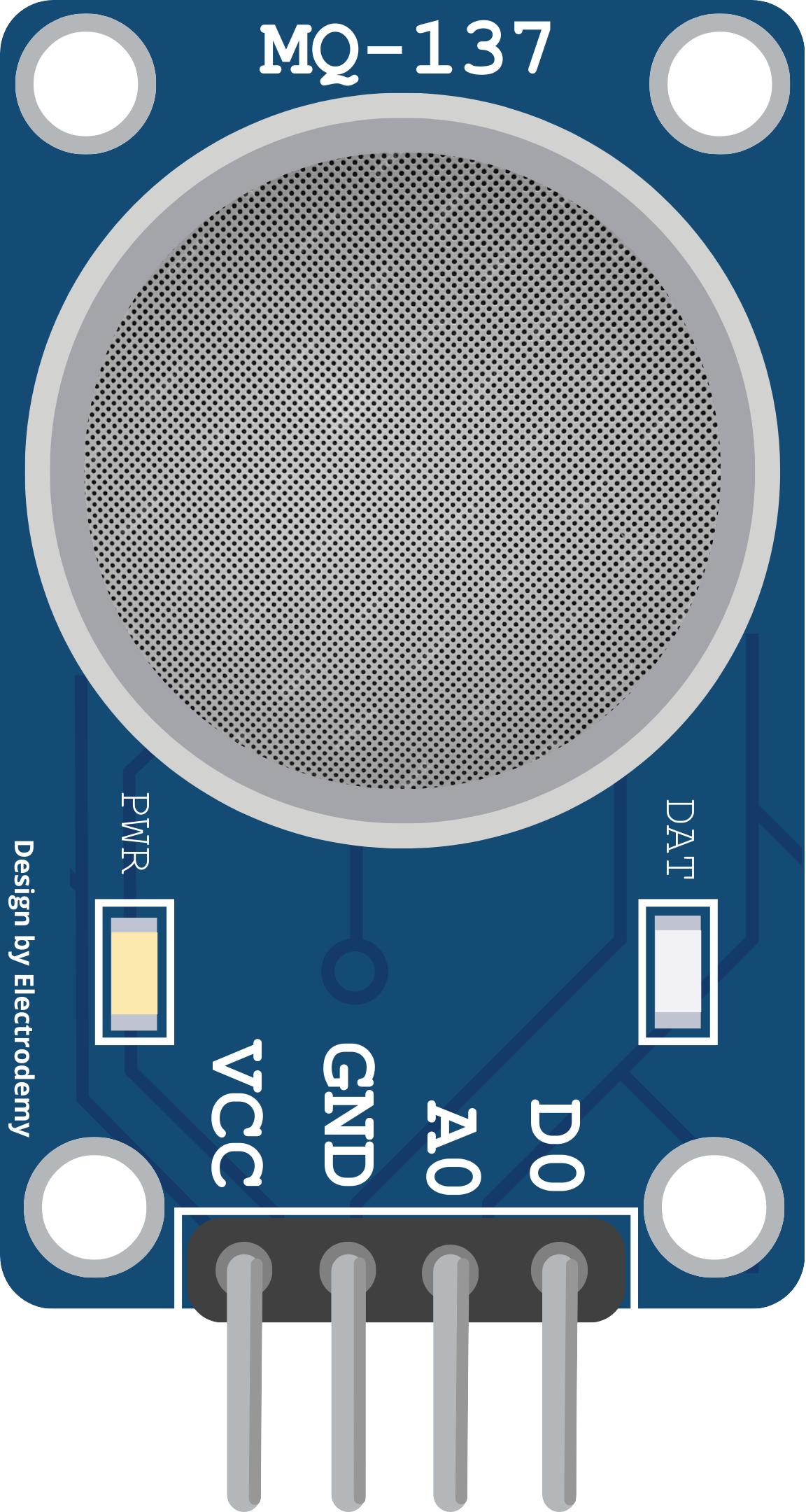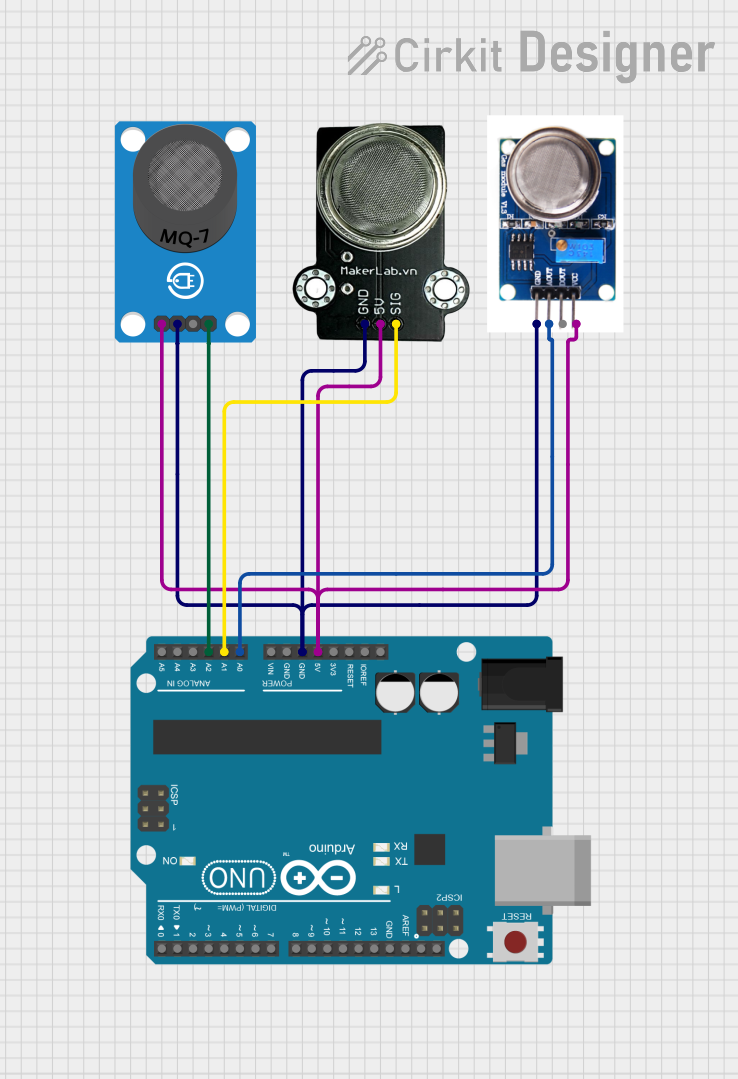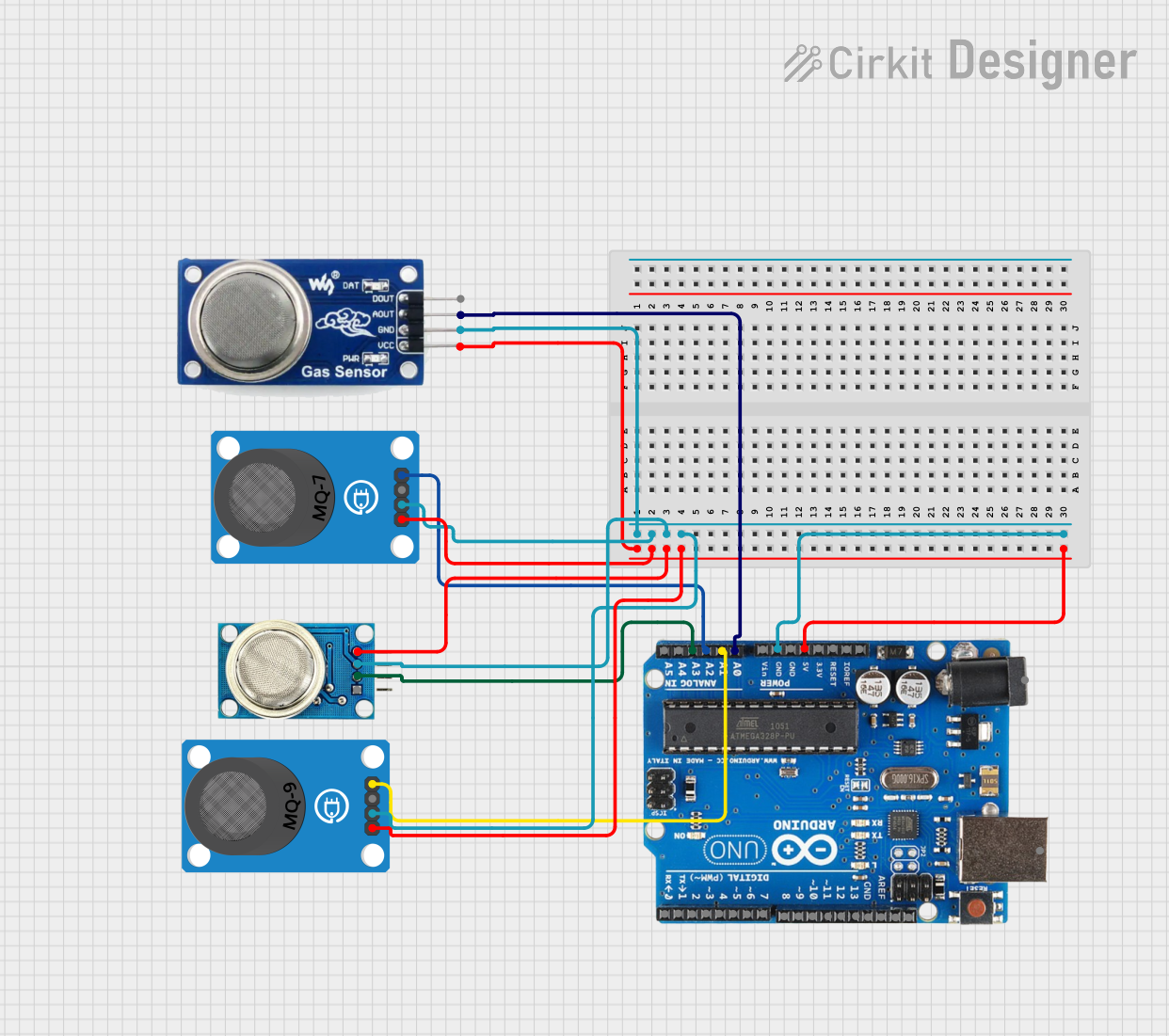
Cirkit Designer
Your all-in-one circuit design IDE
Home /
Component Documentation
How to Use MQ-137 SENSOR AMMONIA GAS: Examples, Pinouts, and Specs

 Design with MQ-137 SENSOR AMMONIA GAS in Cirkit Designer
Design with MQ-137 SENSOR AMMONIA GAS in Cirkit DesignerIntroduction
The MQ-137 is an analog gas sensor module used for the detection of ammonia (NH3) in the air. It is a widely used sensor in various applications such as environmental monitoring, agricultural, industrial processes, and safety systems where the presence of ammonia needs to be detected and measured.
Explore Projects Built with MQ-137 SENSOR AMMONIA GAS
Arduino UNO Based Multi-Gas Detector

This circuit is designed for environmental monitoring, featuring an Arduino UNO microcontroller interfaced with three different gas sensors: MQ-7 for carbon monoxide (CO) detection, MQ131 for ozone (O3) measurement, and MQ-135 for general air quality assessment. The sensors are powered by the Arduino's 5V output and their analog signals are read through the Arduino's analog input pins A0, A1, and A2 respectively. The embedded code reads the analog values from the sensors and outputs the readings via the serial interface, allowing for real-time monitoring of the gases.
 Open Project in Cirkit Designer
Open Project in Cirkit DesignerMulti-Gas Sensor System with Arduino Uno

This circuit is a multi-gas sensor system that uses an Arduino Uno to read analog values from four different gas sensors (MQ-135, MQ-7, MQ-8, and MQ-9). The Arduino collects data from these sensors and prints the readings to the Serial Monitor for monitoring air quality.
 Open Project in Cirkit Designer
Open Project in Cirkit DesignerMulti-Gas Detection System with Arduino and MQ Sensors

This circuit is designed to monitor various gases using a series of MQ gas sensors (MQ-2, MQ-3, MQ-4, MQ-5, MQ-6, MQ-7, MQ-8, MQ-9, and MQ-135), each providing digital outputs to an Arduino UNO microcontroller. The Arduino is also connected to a piezo speaker for audible alerts and multiple LEDs with resistors, likely for visual status indicators. An Adafruit TCA9548A I2C multiplexer is included, suggesting the potential for I2C sensor expansion or managing multiple I2C devices.
 Open Project in Cirkit Designer
Open Project in Cirkit DesignerArduino-Based Air Quality Monitoring System with MQ Sensors

This circuit is an air quality monitoring system using an Arduino UNO microcontroller connected to three different gas sensors: MQ-7 for carbon monoxide, MQ131 for ozone, and MQ-135 for general air quality. The Arduino reads analog signals from these sensors and outputs the readings via the serial interface for monitoring purposes.
 Open Project in Cirkit Designer
Open Project in Cirkit DesignerExplore Projects Built with MQ-137 SENSOR AMMONIA GAS

Arduino UNO Based Multi-Gas Detector
This circuit is designed for environmental monitoring, featuring an Arduino UNO microcontroller interfaced with three different gas sensors: MQ-7 for carbon monoxide (CO) detection, MQ131 for ozone (O3) measurement, and MQ-135 for general air quality assessment. The sensors are powered by the Arduino's 5V output and their analog signals are read through the Arduino's analog input pins A0, A1, and A2 respectively. The embedded code reads the analog values from the sensors and outputs the readings via the serial interface, allowing for real-time monitoring of the gases.
 Open Project in Cirkit Designer
Open Project in Cirkit Designer
Multi-Gas Sensor System with Arduino Uno
This circuit is a multi-gas sensor system that uses an Arduino Uno to read analog values from four different gas sensors (MQ-135, MQ-7, MQ-8, and MQ-9). The Arduino collects data from these sensors and prints the readings to the Serial Monitor for monitoring air quality.
 Open Project in Cirkit Designer
Open Project in Cirkit Designer
Multi-Gas Detection System with Arduino and MQ Sensors
This circuit is designed to monitor various gases using a series of MQ gas sensors (MQ-2, MQ-3, MQ-4, MQ-5, MQ-6, MQ-7, MQ-8, MQ-9, and MQ-135), each providing digital outputs to an Arduino UNO microcontroller. The Arduino is also connected to a piezo speaker for audible alerts and multiple LEDs with resistors, likely for visual status indicators. An Adafruit TCA9548A I2C multiplexer is included, suggesting the potential for I2C sensor expansion or managing multiple I2C devices.
 Open Project in Cirkit Designer
Open Project in Cirkit Designer
Arduino-Based Air Quality Monitoring System with MQ Sensors
This circuit is an air quality monitoring system using an Arduino UNO microcontroller connected to three different gas sensors: MQ-7 for carbon monoxide, MQ131 for ozone, and MQ-135 for general air quality. The Arduino reads analog signals from these sensors and outputs the readings via the serial interface for monitoring purposes.
 Open Project in Cirkit Designer
Open Project in Cirkit DesignerCommon Applications and Use Cases
- Air quality monitoring
- Industrial leak detection
- Agricultural monitoring for livestock environments
- Refrigeration systems
- Safety systems in chemical plants
Technical Specifications
Key Technical Details
- Detection Gas: Ammonia (NH3)
- Concentration Range: 5 ppm to 500 ppm
- Supply Voltage (Vcc): 5V ± 0.1
- Heater Voltage (VH): 5V ± 0.1
- Heater Current: Less than 180 mA
- Load Resistance: Adjustable
- Preheat Duration: 20 minutes
- Output: Analog voltage signal output
Pin Configuration and Descriptions
| Pin Number | Pin Name | Description |
|---|---|---|
| 1 | VCC | Power supply (5V) |
| 2 | GND | Ground |
| 3 | DO | Digital output (TTL) |
| 4 | AO | Analog output |
Usage Instructions
How to Use the Component in a Circuit
- Powering the Sensor: Connect the VCC pin to a 5V supply and the GND pin to the ground.
- Analog Output: Connect the AO pin to an analog input on your microcontroller to read the analog voltage corresponding to the concentration of ammonia.
- Digital Output: The DO pin can be connected to a digital input on your microcontroller. It can be used to trigger an action when the gas concentration exceeds a certain threshold, which can be set using the onboard potentiometer.
Important Considerations and Best Practices
- Ensure the sensor is preheated for at least 20 minutes before taking accurate readings.
- Avoid exposure to high concentrations of ammonia for extended periods as it may lead to sensor degradation.
- Calibrate the sensor for the environment in which it will be used to ensure accurate readings.
- The sensor's sensitivity varies with temperature and humidity, so these factors should be considered during use.
Troubleshooting and FAQs
Common Issues Users Might Face
- Inaccurate Readings: Ensure the sensor is properly calibrated and has been preheated.
- No Output Signal: Check the power supply and connections to the sensor.
- Sensor Not Responding: The sensor may be damaged due to high gas concentrations or incorrect voltage application.
Solutions and Tips for Troubleshooting
- Calibration: Perform regular calibration using a known concentration of ammonia to maintain accuracy.
- Connection Check: Verify all connections are secure and the power supply is within the specified range.
- Sensor Replacement: If the sensor has been exposed to high concentrations of ammonia or has been in use for an extended period, consider replacing it.
Example Code for Arduino UNO
// MQ-137 Ammonia Gas Sensor Example Code
const int analogPin = A0; // Analog input pin connected to AO pin of the sensor
void setup() {
Serial.begin(9600); // Initialize serial communication at 9600 baud rate
}
void loop() {
int sensorValue = analogRead(analogPin); // Read the analog value from sensor
float concentration = sensorValue * (10.0 / 1023.0); // Convert to concentration
// Note: The conversion factor will vary depending on calibration
Serial.print("Ammonia Concentration: ");
Serial.print(concentration);
Serial.println(" ppm");
delay(1000); // Wait for a second before reading again
}
Note: The above code is a simple example to read the analog value from the MQ-137 sensor. The conversion from the analog value to the actual concentration in ppm requires calibration with a known ammonia concentration. The 10.0 / 1023.0 factor is an example and should be replaced with the appropriate calibration factor for your specific setup.
Remember to keep code comments concise and within the 80 character line length limit.